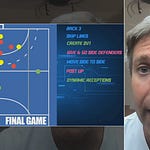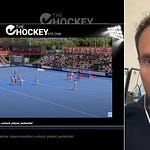If there’s one point every field hockey coach needs to take home from this masterclass with Fede Tanuscio, it’s all about how you structure your team defensively and maintain discipline when playing with one player less. For experienced coaches, this isn’t just a tactical puzzle—it’s a mental one, and your team’s response in these moments often defines the outcome of tight games.
Why is Compactness So Important?
When you lose a player, your defensive structure is compromised, but the solution isn’t to chase; it’s to tighten. “The most important principle, number one, is compactness,” says Fede Tanuscio. “Reduce the gaps between the lines.” It’s a simple concept: resist the urge for individuals to step out of shape or overcorrect. Your top priority must be to keep the space between defenders, midfielders and strikers crowded, denying the opposition the passing lanes and shooting angles they naturally hunt for.
In practical terms, that means coaches should routinely reinforce the habits of maintaining line integrity and teaching players to “slide” and “rotate” as a collective, not as individuals. During reduced-number scenarios in training, set your back line and midfield to always move together, keeping the distances tight. Drill zonal defence and work on communication—over-communicate, in fact—so that when a card comes, your team instinctively contracts instead of fracturing. To quote Fede Tanuscio:
“The job is not recovering the ball every time but delay, frustrate, and intercept. If your compactness breaks, you get mistakes, then cards, and you give away penalty corners, ...”
Translating This Into Everyday Training
It’s all too easy for coaches to focus solely on their preferred 11-a-side structure. Don’t fall into that trap. Instead, make underload scenarios a staple. At least once a week, run segments with a player missing, and alternate whom you “sacrifice” (striker, midfielder, etc) depending on the context you want the team to explore.
Run simple sessions that emphasize protecting the centre, sliding in blocks, and recovering backward instead of going for loose tackles. The approach isn’t purely defensive; training these principles also helps develop your players’ decision-making, patience, and collective confidence under pressure.
Critically, reinforce discipline when numbers are down. As Fede Tanuscio emphasized, “Avoid the second card.” The mental approach is what often leads to a second yellow or, worse, a red. Frustrated players who fly into tackles or lose patience with compact zonal marking aren’t just risking a goal against, but another numerical disadvantage.
Why This Is a Coach’s Priority
The lesson here isn’t just tactical—it’s psychological and cultural. Teams that are well-drilled in these principles weather tough spells with a sense of collective resilience. By embedding compactness and discipline into your weekly routine, your team will meet adverse moments with composure rather than panic.
“One player down is not defeat… You have to trust that even in bad moments you can pass through it in a good way.”
Why You’ll Want to Watch the Whole Masterclass
This workshop isn’t just about diagrams or theory—it’s packed with real-world analysis, practical session exercises, and video examples that show exactly how elite teams adapt when shorthanded. If you want your side to handle these pressure moments with the same poise as the very best, there’s no substitute for seeing the principles in action and digging deeper into how coaches can design sessions and communication structures around these game-defining situations.
Watch it in full and read on here ↓ (only for our paid subscribers) for a breakdown of the three main takeaways that will shape your approach as a coach, complete with actionable advice and more insights.Listen to this episode with a 7-day free trial
Subscribe to The Hockey Site to listen to this post and get 7 days of free access to the full post archives.












